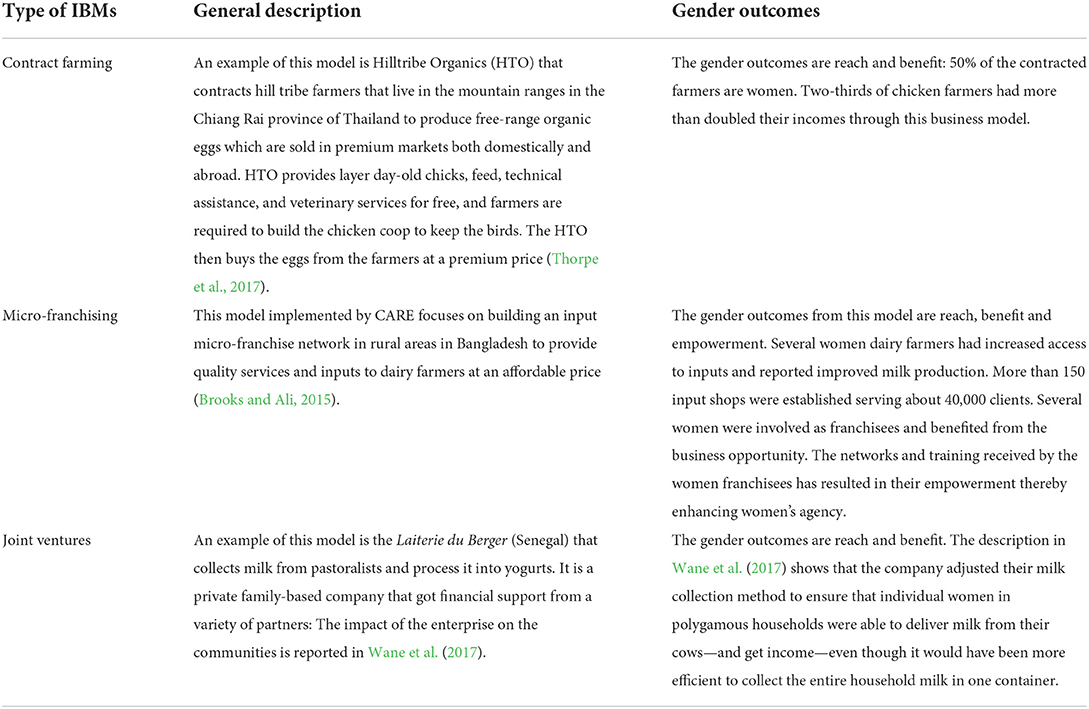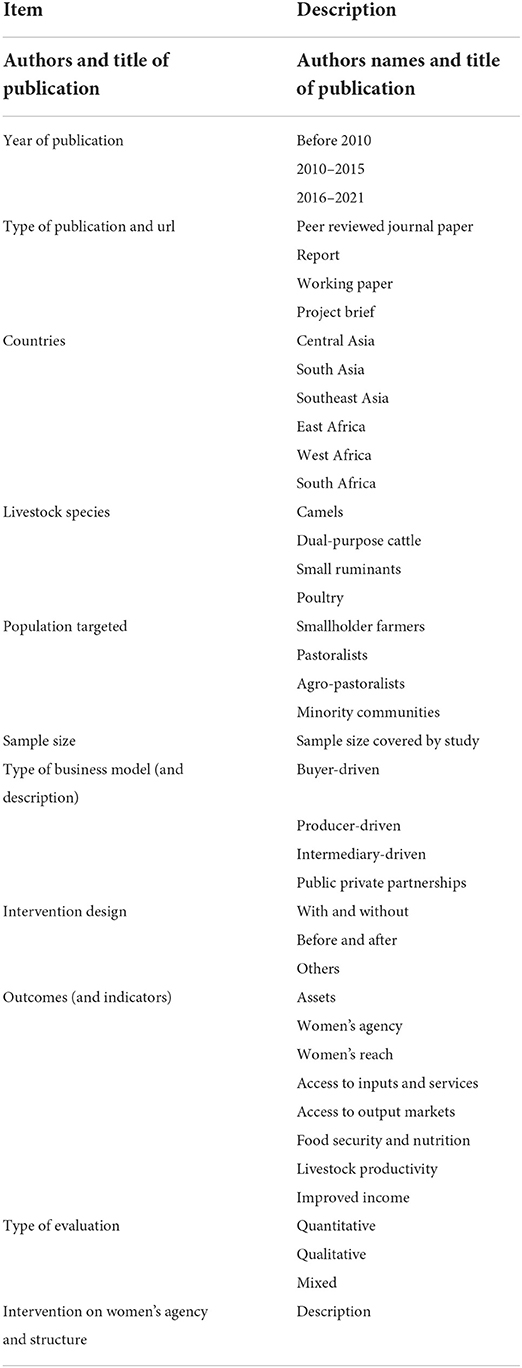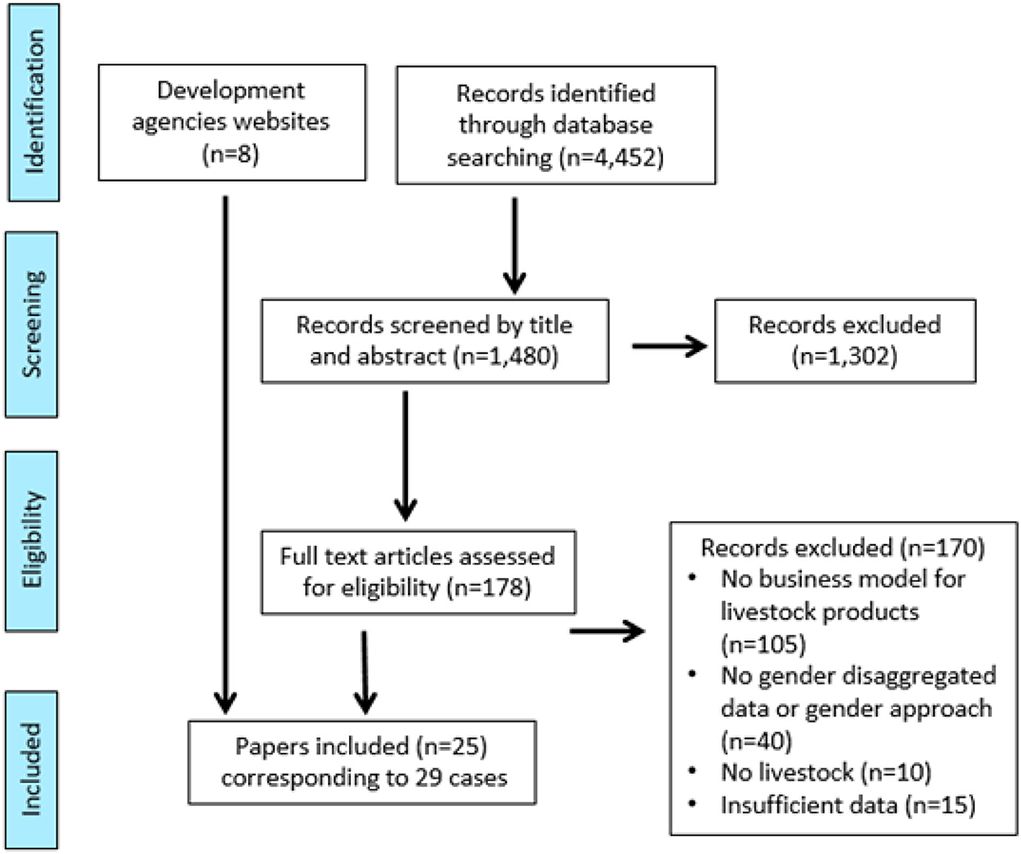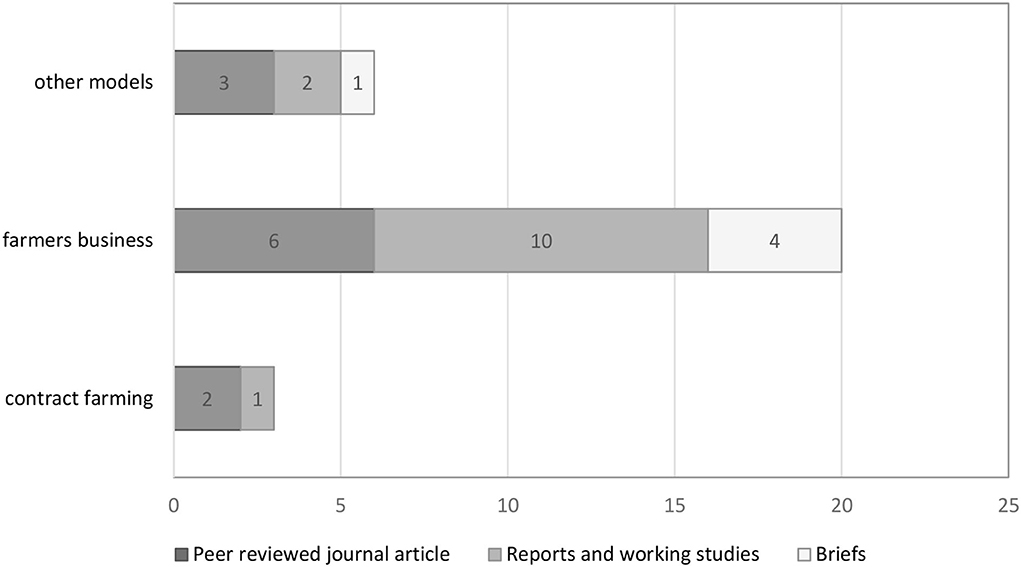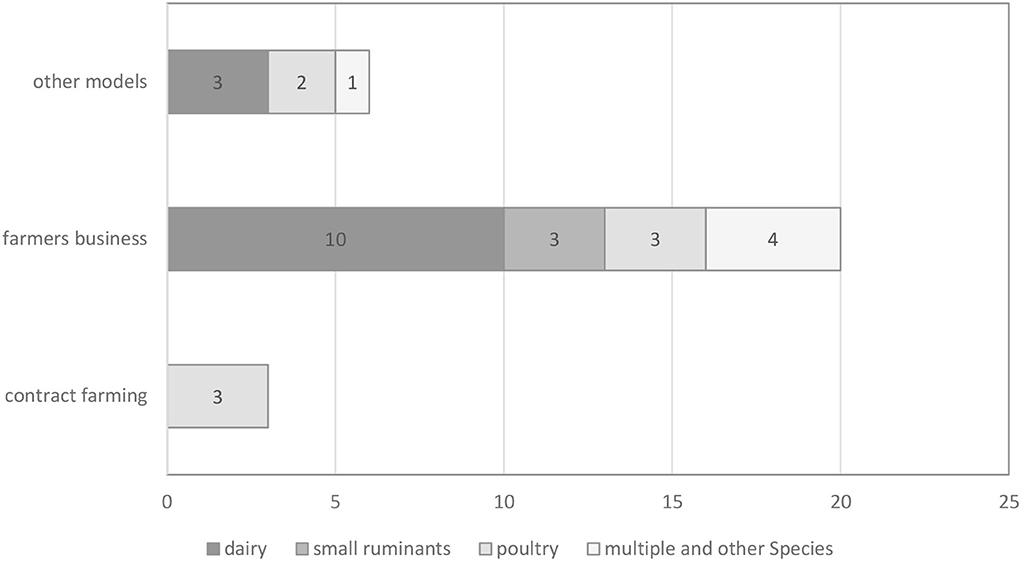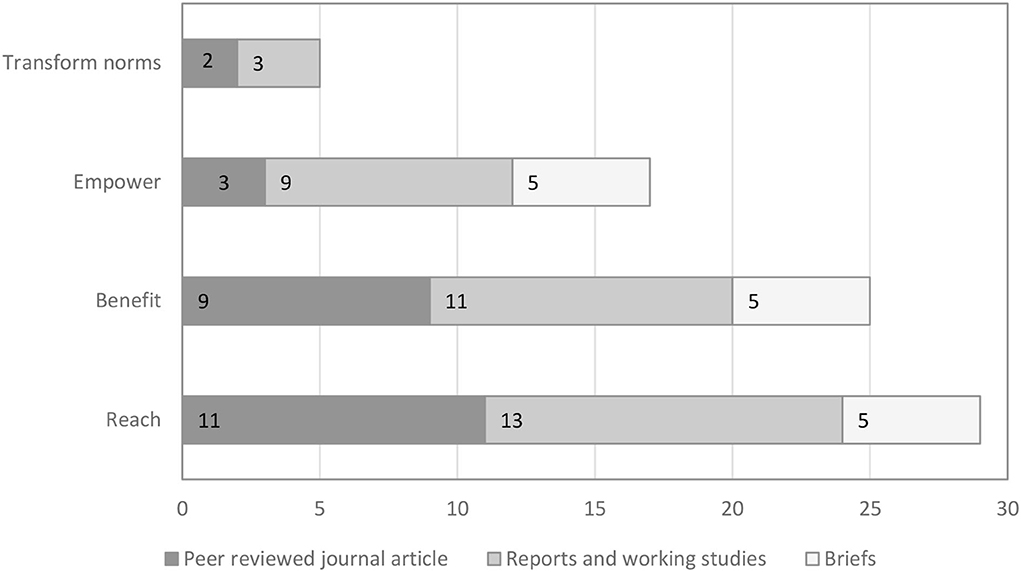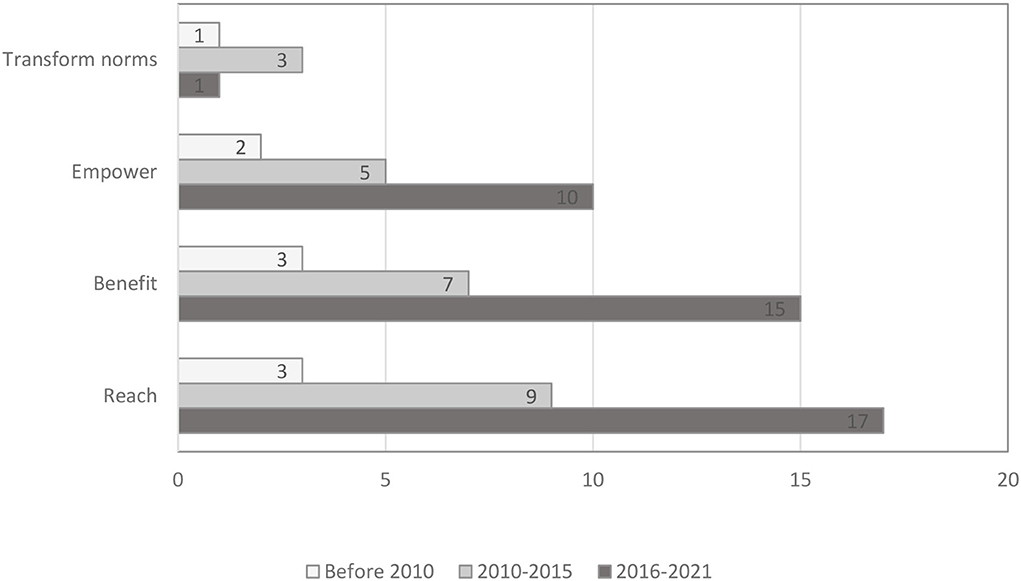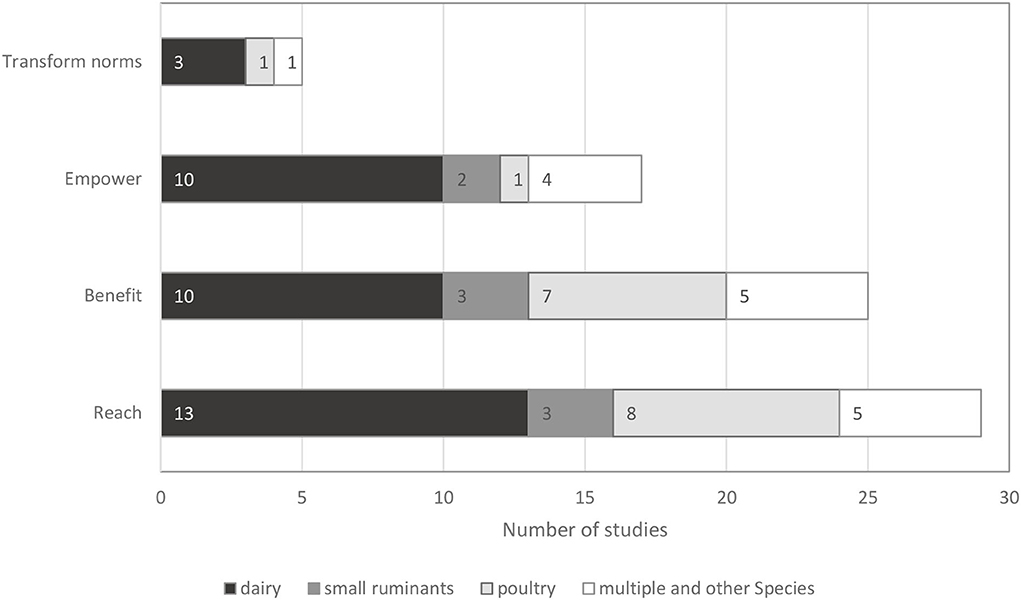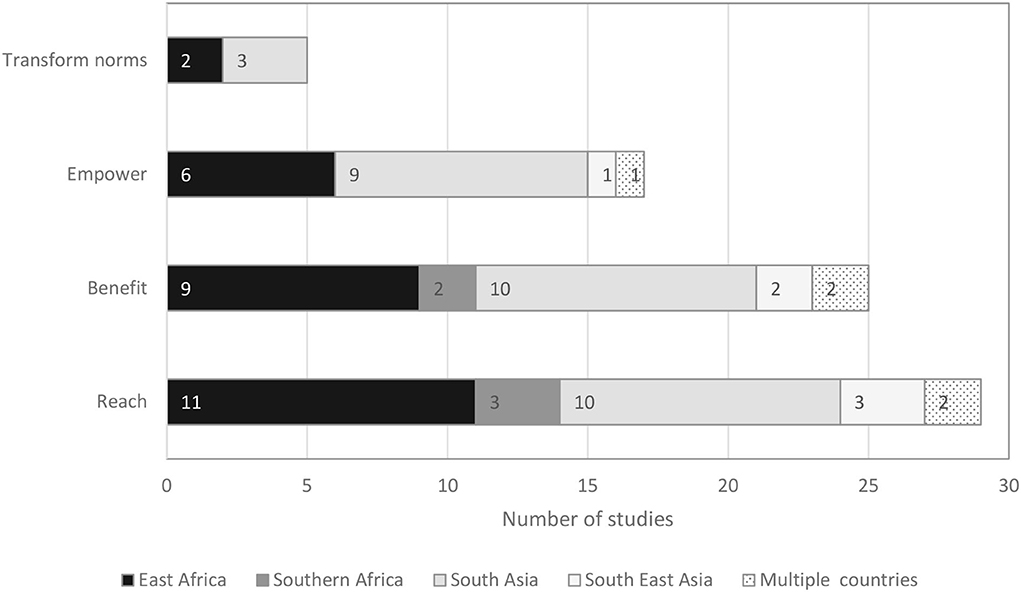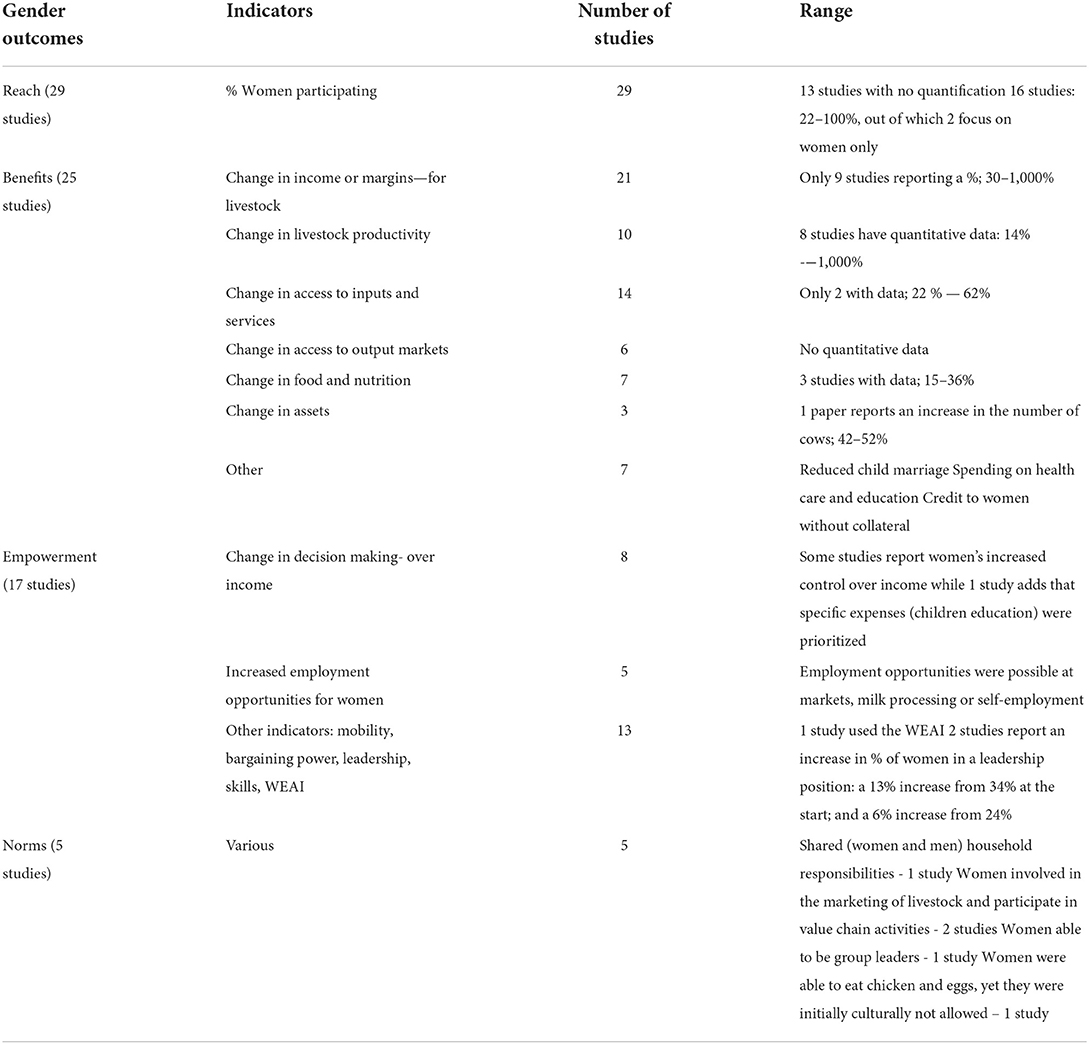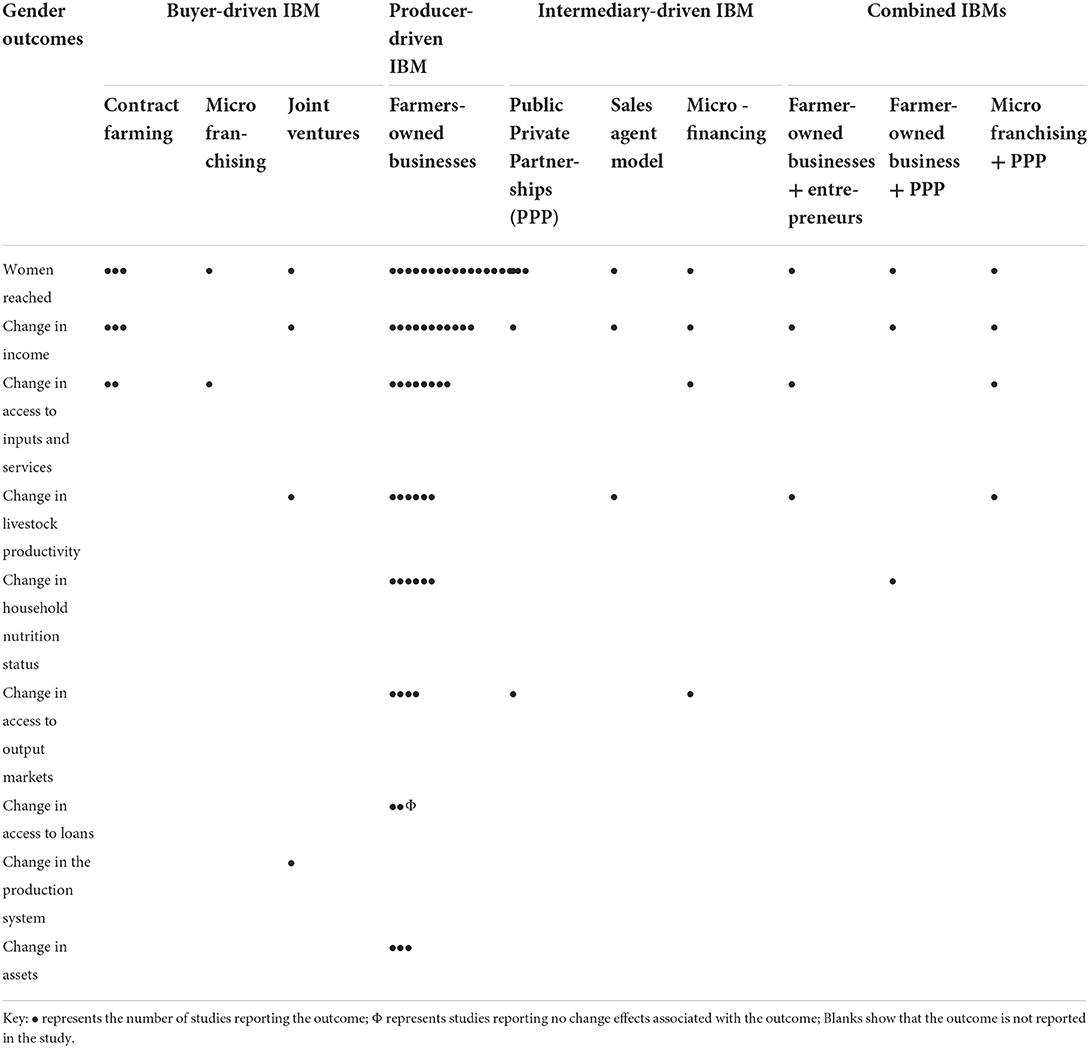- 1Policies, Institutions and Livelihoods Program, International Livestock Research Institute, Nairobi, Kenya
- 2Policies, Institutions and Livelihoods Program, International Livestock Research Institute, Kampala, Uganda
Gender inequality is one of the key challenges of the twentyfirst century. Gender equality is one of the sustainable development goals (SDGs) and getting a more equal society is increasingly seen as supporting the achievement of the other SDGs. At the same time, the question remains: how to support gender equality in practice? This paper looks at gender-inclusive business models in the livestock sector. Such models can contribute to women's economic empowerment (an intermediate indicator toward gender equality) directly by addressing barriers to women's participation in livestock markets, or indirectly by involving them as implicit beneficiaries where such businesses provide services or products in circumstances where women face constraints such as poor access to inputs. A review of the literature was conducted to assess inclusive business models that are successful in increasing women's participation in livestock or livestock products marketing and its associated benefits and outcomes, focusing on low- and middle-income countries. The review included peer-reviewed publications, gray literature, and websites from non-government organizations that implement inclusive business models. A literature search was conducted using Google scholar and Research4Life databases for publications since 2010. Websites from development and international organizations implementing inclusive business models were also searched. Data from included records were extracted according to a pre-defined extraction form. A total of 29 studies were included. Results from the review show scarcity of literature and lack of research rigor in the few studies that document outcomes associated with inclusive business models. The few studies on gender-inclusive business models are mainly on collective action and contract farming to support women and men farmers to access markets, inputs, and services. Tangible benefits for women involved are reported, including women empowerment and change in gender norms to some extent.
Introduction
Poverty and gender equality continue to be major challenges worldwide, particularly in the developing world. Although recent decades have seen significant reductions in poverty and food insecurity, the COVID-19 pandemic has reversed some of these gains. For the agricultural sector in general and livestock in particular, there are many trade-offs between the different goals of sustainability, economic growth, social and gender equity, and environmental concerns (Salmon et al., 2018). Inclusive business models (IBMs) aim at balancing economic interests and equity objectives in agricultural value chains and are based on the principle that there are mutual benefits for poor farmers and the business community (FAO, 2015). The “inclusive” element of the IBM concept refers to integrating the less advantaged (for example, smallholder groups, and small enterprises) to equally benefit from agricultural value chains. The models are intended to circumvent existing market failures and the inefficiencies that limit the poor and disadvantaged from accessing input markets and profitable output markets for their produce.
Varying business models, approaches, and innovations, using different terminologies about IBMs, have been implemented by researchers and development partners. Some of the terminologies used to depict IBMs include the following: Making Markets Work for the Poor; Business Linking Smallholder Farmers and Small Companies; Opportunities for the Majority; Inclusive Market Development Concept; the Pro-poor Value Chain Development Concept; the Win-Win Profit Approach (Naguib et al., 2013). Despite the diverse contextualization of the IBM concept, some consensus has been reached on what constitutes an inclusive business model (FAO, 2013). The business model is considered more inclusive when it is accessible to farmers with fewer assets, particularly women and minority groups; uses trading practices according to the needs of smallholders that provide benefits such as profit, stable market outlets, shared risks, access to services and finance; does not create dependency on any one value chain or buyer and provides profitable diversified market options for smallholders; builds the capacity of farmers and farmer groups according to market needs; uses transparent platforms and forums to identify and solve problems. Inclusive business models typically focus on building the capacity and resilience of local systems, leveraging the incentives and resources of the private sector, ensuring the beneficial inclusion of marginalized actors in the value chain, and stimulating change and innovation in market systems.
The private sector, ranging from small local businesses to large international corporations, is widely recognized as having a critical role to play in contributing to poverty reduction, by largely making their businesses inclusive. The inclusive element addresses the challenge of linking commodity-dependent smallholders and small actors to markets by stimulating local business model partnerships which include benefits for smallholder groups and small value chain actors (FAO, 2015). Supporting these business models and strengthening market linkages between smallholder producers and buyers can improve the overall competitiveness of a value chain and reduce poverty. Most smallholder producers have poor access to markets for their products due to numerous costs that vary with gender, such as transaction costs; output prices; turnover; uncertainty; cooperation and collective initiatives; and labor and capital investment (Verhaegen and Van Huylenbroeck, 2001).
Although IBMs in agricultural value chains have been widely promoted by development partners (Jordan-kirwan, 2019; for example FAO CARE, 2019; Jordan-kirwan, 2019), most of the studies have focused on the crop sector. By contrast, there is minimal evidence on how the models may enhance women's participation in livestock markets, despite the gender-related constraints associated with livestock production and marketing. These constraints include limited mobility; time poverty; lack of access to assets that would facilitate their participation, such as transport, communication assets, and bank accounts; and lack of access to market information (Sanginga et al., 2013). These gender-based constraints are known to limit women's participation more in farm-gate markets rather than markets outside their homes. This is a common phenomenon for most women in low- and middle-income countries. Failure to address these constraints not only undermines the potential of agricultural value chains to contribute to economic and social progress but also perpetuates gender inequalities and poverty (Bamber and Staritz, 2016). Women's participation in markets has been found to diminish even further as vertical integration of markets occurs, and as markets move away from sites of production and the value chain becomes more complex with multiple actors (Pionetti et al., 2011).
The IBMs—particularly those that are gender-sensitive—have great potential to contribute to women's economic empowerment directly or indirectly. They can contribute directly by increasing the participation of women in markets and addressing gender-related barriers to participation. Some of the gender-based constraints are associated with deeply rooted gender norms and practices. For instance, women in low-income communities, are often perceived as caregivers and homemakers, rather than successful entrepreneurs. In some communities, they face mobility restrictions and are not expected to move around and interact with clients, especially men (Asian Development Bank, 2016). Some cultures perpetuate low agencies and rights for women as they are not allowed to make decisions for themselves. There are high levels of illiteracy among poor rural women, which constrains their involvement in businesses. Other studies have highlighted women's limited participation in training or extension services, with men being these usually invited to such capacity-strengthening opportunities, or those able to attend (World Bank, 2014).
The IBMs can also contribute indirectly by involving women as implicit beneficiaries of inclusive business models where such businesses provide services or products in areas where women bear specific disadvantages such as poor access to inputs. In the latter case, IBM creates tangible benefits for women but does not necessarily address their empowerment specifically. The few IBMs that focus on the livestock sector have tended to be gender blind, yet men and women may gain differently from such efforts as they face different constraints. For instance, a private-public partnership model in a pastoral community in Kenya, run under the auspices of the ministries of livestock and social services and involving both male and female livestock traders, resulted in the establishment of livestock markets closer to the community (Were, 2009). This effort resulted in benefits not only for women but for men, as well as for the local community and the region in terms of increased trade and revenue from livestock sales. Having livestock markets in proximity to their homes resulted in increased participation of women in livestock markets in a community that discouraged women to engage in the livestock trade, partly because the markets were too far and challenging social norms restricting women's economic participation.
Most IBMs are implemented by development programs or the private sector and tend not to integrate rigorous monitoring and evaluation systems. This results in a lack of quality evidence on livelihood outcomes due to a lack of rigor in the experimental designs. In this paper, a conceptual framework on gender-inclusive business models in livestock value chains is presented and used to situate and analyze key livestock gender IBM studies. This review allows documentation of various gender-inclusive business models and approaches that have enhanced the participation of women in livestock marketing, and their effects on women's empowerment and livelihoods. Evidence from this review will enable the identification of best practices to guide interventions aimed at promoting gender-inclusive business models in livestock value chains. We define gender-inclusive business models in this paper as pro-poor, equitable, and profitable business activities that integrate women in livestock value chains and/or address specific gender-based constraints to enhance women's participation in the value chain while generating positive gender outcomes.
Conceptual framework
There are numerous conceptual frameworks for IBMs (Seville et al., 2011; FAO, 2015) with FAO (2008) categorizing them into four main models: producer-driven, buyer-driven, public-sector-driven, or intermediary-driven. While these models are a useful categorization, Chamberlain and Anseeuw (2017) highlight the need to combine them into “hybrid entities” during implementation. More recently, authors like German et al. (2020) have questioned the validity of the concept of IBM, given reduced government support to smallholder farmers and the increasing complexity of value chains, and since agribusinesses tend to be more exclusive than inclusive. Another gap in the IBM literature is the extent to which outcomes or impacts are tracked, rather than assumed. Chege et al. (2014) for example expand the analysis of impacts of contract farming—sales to supermarkets—beyond a change in productivity and income and look at human nutrition and women's control over income, showing trade-offs.
There are far fewer studies looking at gender-inclusive business models. KIT et al. (2012) present an innovative framework, looking at the interactions between chain governance and chain activities, and analyses the interventions using the lens of agencies (women's capacities) and structures (women's opportunities). The sequence of interventions is also important. Thorpe et al. (2017) focus on the “most marginalized” and thorough literature review and key informant interviews (KIIs) and come up with 5 entry points, with the first entry point being similar to the KIT's first activities on supporting women's capacities (women's agencies).
Rubin et al. (2010) and Johnson et al. (2018) identify three levels of women's engagement in agricultural development projects that can also be applied to business models, namely reach, benefit and empowerment. Projects that focus on reach, emphasize engaging women in project activities and seek to reduce barriers to participation, with the indicator being limited to the number of women involved in project activities. Those that focus on benefiting women consider gendered needs, preferences, and constraints to ensure that women benefit from project activities; the indicators of interest are more complex, including changes in women's income or capacities. Finally, projects looking at empowering women involve strengthening their ability to make strategic life choices (Johnson et al., 2018). Indicators of empowerment include control over income or women's ability to make major household decisions, for example on children's education. These 3 categories [or 4 in Rubin et al. (2010), in addition to “performance”] are comparable to the criteria for evaluating IBMs in Asian Development Bank (2016): their reach, quality (in terms of effects the business has on low-income people), their financial sustainability and systemic impact and innovation, which for gender-inclusive approaches would be looking at women empowerment. Looking at sustainability and replication, a fourth category “transform gender norms” is added by Stoian et al. (2018). While the search strategy did not limit inclusion to papers using these indicators, these three levels were used to categorize the outcomes using the Johnson et al. (2018) framework.
For our analysis that focuses on gender IBMs in livestock value chains, we use the categorization of IBMs from Kaminski et al. (2020) and FAO (2015) and we combine it with the gender outcome levels from Johnson. Following KIT et al. (2012) we identify the interventions on agencies and/or structures, as these will allow us to identify clear entry points and possibly their sequence. Table 1A gives examples of development projects and initiatives that have focused on buyer-driven IBMs in livestock and the associated gender outcomes using the categorization by Kaminski et al. (2020).
In addition, Tables 1B,C provide examples of initiatives that have focused on producer-driven and intermediary-driven IBMs, respectively.
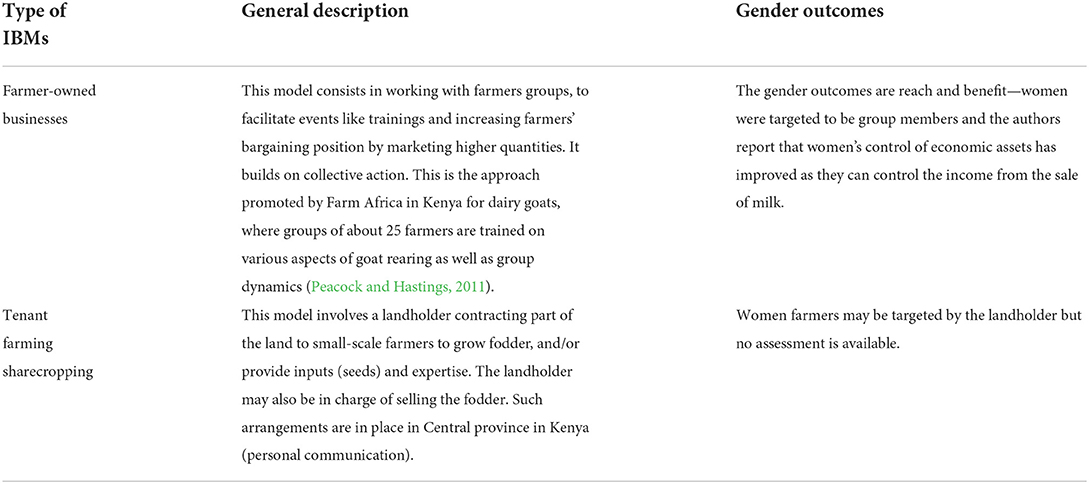
Table 1B. Examples of producers-driven gender-inclusive business models, and reported gender outcomes.
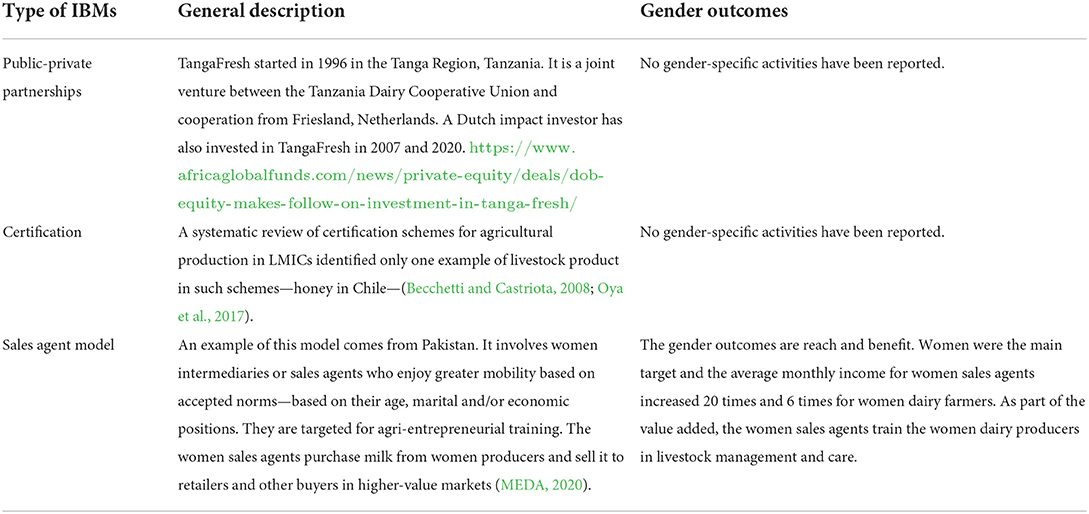
Table 1C. Examples of intermediary-driven gender-inclusive business models, and reported gender outcomes.
The same structure is used to analyze the papers selected from the literature review described in the next section.
Methodology
The methodology for the review followed the Preferred Reporting Items for Systematic Reviews and Meta-Analyses (PRISMA) guidelines (Moher et al., 2009). The review included the following key aspects: (a) formulating a research question, (b) Population, Intervention, Comparison, Outcome (PICO) framework to develop literature search strategies, and eligibility criteria definition (c) identification of relevant studies, (d) selection of studies, (e) data extraction, and (f) data synthesis and reporting the results. The protocol, in particular the research question and the conceptual framework, benefited from suggestions from livestock and gender experts during an in-house seminar. A broader stakeholders' consultation was not possible to organize at the time of the study.
Research question
The key research question was “Which business models or approaches in agricultural value chains, with a focus on livestock, are successful in increasing women's participation and benefits from livestock in particular?.”
Inclusion and exclusion criteria
The setting of the review included low- and middle-income countries (LMICs) as defined by the World Bank income categorization (World Bank, 2021). The population was small-scale and agro-pastoral agricultural households, with a focus on livestock-keeping households or other value chain actors involved in the livestock business. The interventions analyzed comprised business models aimed at increasing women's participation and benefits from livestock activities, by value chain actors themselves—for example, livestock buyers seeking to include more women in their supply chains or women groups looking for new markets, or development agencies such as an NGO creating linkages between a women's group and a marketing firm. The gender outcomes of interest, therefore, refer to the types of project approaches as described in Johnson et al. (2018): reach, benefit, and empowerment.
Papers included in the search included primary empirical research work, providing a comparison either before and after the interventions, and/or with and without intervention. Publications included peer-reviewed publications and gray literature, including websites from NGOs that implement business inclusive approaches. Papers identified by the searches were screened for inclusion in the analysis. The inclusion criteria were guided by the following questions: (a) is there a business model/approach for livestock implemented (or tested)? (b) was gender-disaggregated data collected, does the approach differ between women and men, or was the target women only? (c) did the intervention take place in an LMIC? If the paper met the three inclusion criteria, the paper was included. Exclusion criteria included systematic reviews, study protocols, studies that did not include livestock business models, and those that were not in an LMIC setting. Studies that did not report sex-disaggregated data or a gender approach were also excluded. Literature published before 2010 was also excluded.
Information sources and search strategy
The main sources of information were Google scholar and Research4Life databases. Research4Life includes AGORA, HINARI, ARDI, and OARE databases as well as Scopus which was made available in 2012 (https://www.research4life.org/press-releases/research4life-greatly-expands-peer-reviewed-research-available-to-developing-world/). The search strategies included the combination of the following terms: women or gender; livestock or animal, business linkages or business approaches, and focus on Africa and Asia. The following search terms and combinations were used: [(gender) OR (women)] AND [(livestock marketing) OR (animal marketing)] AND [(business approach) OR (business linkage) OR (business model)] AND [(Africa) OR (Asia)].
Google scholar search resulted in 2,190 hits. Only the first 980 papers, about half of the papers were available and therefore screened. The Research4Life database search was restricted to the following disciplines in the search engine: agriculture, applied sciences, economics, social sciences, women's studies, social welfare and social work, and business. It included articles published since 2010. The search yielded 2,262 hits. Only the first 500 articles were available and therefore screened.
The following websites from development and international organizations were also searched: CARE, SNV, MercyCorps, Heifer International Bangladesh and Nepal, FAO, Asian Development Bank, and the Mennonite Economic Development Associates (MEDA), as these organizations have a track record of implementing livestock development projects. In addition, 20 papers identified by Liverpool-Tasie et al. (2020) that included gender considerations in the agricultural value chains were also considered in the search. The same inclusion and exclusion criteria were applied.
Study selection
Duplicates of papers identified by the searches were removed before data extraction. The titles and abstracts of the papers were screened based on the inclusion criteria. Full texts of papers that met the inclusion criteria were retrieved and then checked for eligibility through complete reading. The process of screening and selecting papers was conducted independently by three reviewers. In cases of discrepancies regarding the inclusion or exclusion of a paper, the review team discussed and resolved through consensus. A table containing the list of excluded studies and reasons for exclusion was prepared and submitted as Supplementary material 1.
Data extraction
Data extraction for each paper was conducted by an independent data extractor and then reviewed by someone else. Data extraction was done using a pre-piloted template developed in the Excel program. The template was tested by the team using a small sample of 5 papers and calibrated prior to utilization. The parameters covered in the data extraction template are presented in Table 2.
Data analysis
Data were analyzed using simple descriptive statistics, specifically frequencies and means in Excel. The conceptual framework presented in section introduction was used to synthesize the selected papers.
Results
A total of 1,480 papers were identified from the two databases, namely Research4Life and Google Scholar, and duplicates were removed. A total of 1,302 papers were excluded, based on titles and abstracts screening. At that level, three criteria were used, without recording the reason(s) for rejection due to the high number of papers: whether the paper analyzed a business model for livestock? Whether the paper reported gender-disaggregated data or a gender approach; and whether the intervention takes place in an LMIC? The number of papers assessed for eligibility based on the full text was 178, with the reasons provided on the PRISMA chart in Figure 1. The process resulted in a total of 29 cases presented in 25 papers. The papers have been submitted as Supplementary material 2.
Publication types and IBMs
A total of ten different IBMs were identified. The two dominant types were producers-driven, specifically farmers' owned businesses (18 studies), and contract farming (3 studies) which is categorized under buyer-driven models. The 29 studies were reclassified into three types: farmers' businesses (including farmers-owned businesses and those combining entrepreneurship and public-private partnerships - PPP); contract farming; and all the other cases (micro-franchising, with or without PPP, micro-financing, sales agent model, Joint venture, and PPP). Overall, the analysis includes 20 studies of farmers' owned businesses, 3 studies of contract farming, and 6 studies of other types. From the review, results showed that combinations of IBMs were often used—there were 3 combinations: two with farmers-owned businesses (one combined with PPP on poultry; and one with entrepreneurs on dairy); and one with micro-franchising and PPP on poultry, each represented by one paper.
In terms of the publication types, about the same number of peer-reviewed articles (11) and reports (13) were identified, with five briefs providing limited but sufficient details for the analysis. The publication types are presented in Figure 2. While being cautious due to the small number of studies, two out of the three studies on contract farming were published in journal articles, compared to six out of 20 for farmers' businesses. Contract farming models have been promoted as inclusive models by various authors (Thorpe et al., 2017; Beesabathuni et al., 2018), possibly more by academics and researchers rather than development agencies, the latter disseminating their work more in reports and briefs.
In terms of years of publication, it is worth noting that the three studies on contract farming were very recent, all having been published after 2016.
Most of the IBMs focused on dairy cows. Thirteen of the studies focused on dairy, 8 on poultry, 5 on multiple species, and 3 on small ruminants (Figure 3). The 3 studies that focused on small ruminants used farmers' owned business models while for the multiple species, different IBMs were identified. For dairy, the most common type of IBM was a farmer-owned business, illustrating the need for collective action for milk—a product sold daily, highly perishable, and of high value.
In terms of geography, East Africa was the region with the highest number of studies (11) followed by South Asia (10). Farmers-owned businesses were also the only type of IBM that covered all species and was the dominant IBM type in the two regions. Contract farming models only dealt with poultry, possibly due to the short production cycle. Of note is that pigs were not represented in all the studies despite also being livestock species with a short production cycle.
Publication types and gender outcomes
As per the inclusion criteria, all publications included at least one “gender reach” outcome, either through models that reach women by integrating them into the livestock value chains or enhancing women's participation in the livestock value chains by addressing specific gender-based constraints such as access to inputs. There were 4 studies (out of 29) that only focused on women being reached without an assessment of the benefits derived from the business models. The ones that indicated the benefits derived from the business model in addition to reaching women or transforming gender norms documented several other benefits such as improved livestock productivity, increased profits or income from livestock, and improved nutrition. A total of 25 papers included an indicator of “benefit” in terms of change in livestock productivity or income (Figure 4). Almost half of the publications addressed women's empowerment and very few, only 5 out of 29, considered the transformation of norms. The publications that addressed transforming norms discussed the outcomes from business models that integrated gender interventions.
For instance (Brooks and Ali, 2015) show how a value chain intervention included gender awareness training specifically targeting men and sensitizing communities about women's contribution to the dairy value chain in Bangladesh and the need for them to be supported without obstacles. This resulted in not only an improvement in women's agency and empowerment illustrated through improved confidence and decision-making over income from dairy but also catalyzed support from men in easing women's labor burden. Studies such as Ravichandran et al. (2021) assessed whether women-only dairy cooperatives or mixed-gender dairy cooperatives result in women empowerment and transformation of norms in India. The results show that women-only cooperative structures at the village level are not strong enough to withstand, let alone transform, disempowering gender and caste norms.
More than half the papers that considered gender outcomes were published between 2016 and 2021 (Figure 5). Overall, there were very few articles that documented the transformation of norms. Tracking and documentation of gender outcomes associated with inclusive business models seem to be nascent and only recently gaining interest in development science.
In terms of livestock species, dairy interventions comprised the highest proportion of studies that documented gender outcomes. For instance, 40 and 59% of the benefit and empower gender outcomes, respectively, were from dairy (Figure 6). Poultry interventions comprised 28% of the reach and benefit gender outcomes. More dairy interventions were associated with studies on the transformation of norms compared to the other livestock species.
The few studies that focused on interventions for the transformation of norms were from South Asia and East Africa (Figure 7). Most of the studies that focused on empowerment and benefit outcomes were from South Asia while for reach most were from East Africa.
Gender outcomes and indicators
A summary of the gender outcomes, indicators, and the number of studies are presented in Table 3. Few studies provided quantitative information on the indicators. All the studies resulted in reach outcome for women, though only 55% quantified the proportion of women reached. Most of the studies, about 72%, reported a change in income from livestock because of the IBMs, though few quantified the change. Other benefits from IBMs included changes in livestock productivity, and access to inputs and services, among others. Studies such as Farm Africa (2002) enhanced access to credit for women by offering credit without collateral. The indicators for empowerment included change in decision-making over livestock income, increased employment opportunities, mobility, and leadership positions for women. Women empowerment resulted in livelihood outcomes such as investment in child education, and health care, and in some cases, such as Boros and Mcleod (2015) reduced child marriages. A detailed description of the IBMs, the gender outcomes, and the livestock species covered are presented in Supplementary material 3.
Inclusive business models and gender outcomes
The farmer-owned business was the dominant IBM and resulted in benefit outcomes and women empowerment (Table 4). Among the eighteen farmer-owned business models, only four of them resulted in reach outcomes for women and no additional benefits. Only 5 IBM studies showed a transformation of norms and were coupled with training in either leadership, entrepreneurship, or gender issues. One of the studies resulting in a transformation of norms was associated with a private-public partnership model and 3 were either purely farmer-owned businesses or a combination of farmer-owned businesses with another model.
The IBM studies and the beneficial outcomes are presented in Table 5 while Table 6 shows the studies associated with empowerment and transformation of norms. The different IBMs as identified in the 29 included studies are listed in the first row of both papers and are driving the change in the outcomes. The buyer-driven models, specifically contract farming and joint-ventures, resulted in benefits associated with income, livestock productivity, and access to inputs and services but not women empowerment or transformation of norms. The joint ventures model study, which focused on pastoral systems, resulted in changes in the production system with women and children remaining in semi-permanent encampments with lactating dairy cows, where they receive animal feeds from the dairy cooperative to sustain milk production, whereas the men of the community continued the nomadic pastoral practices. In two studies, the farmer-driven business models resulted in improved access to financial credit for women through savings and credit groups. However, one study showed no change in credit access for women.
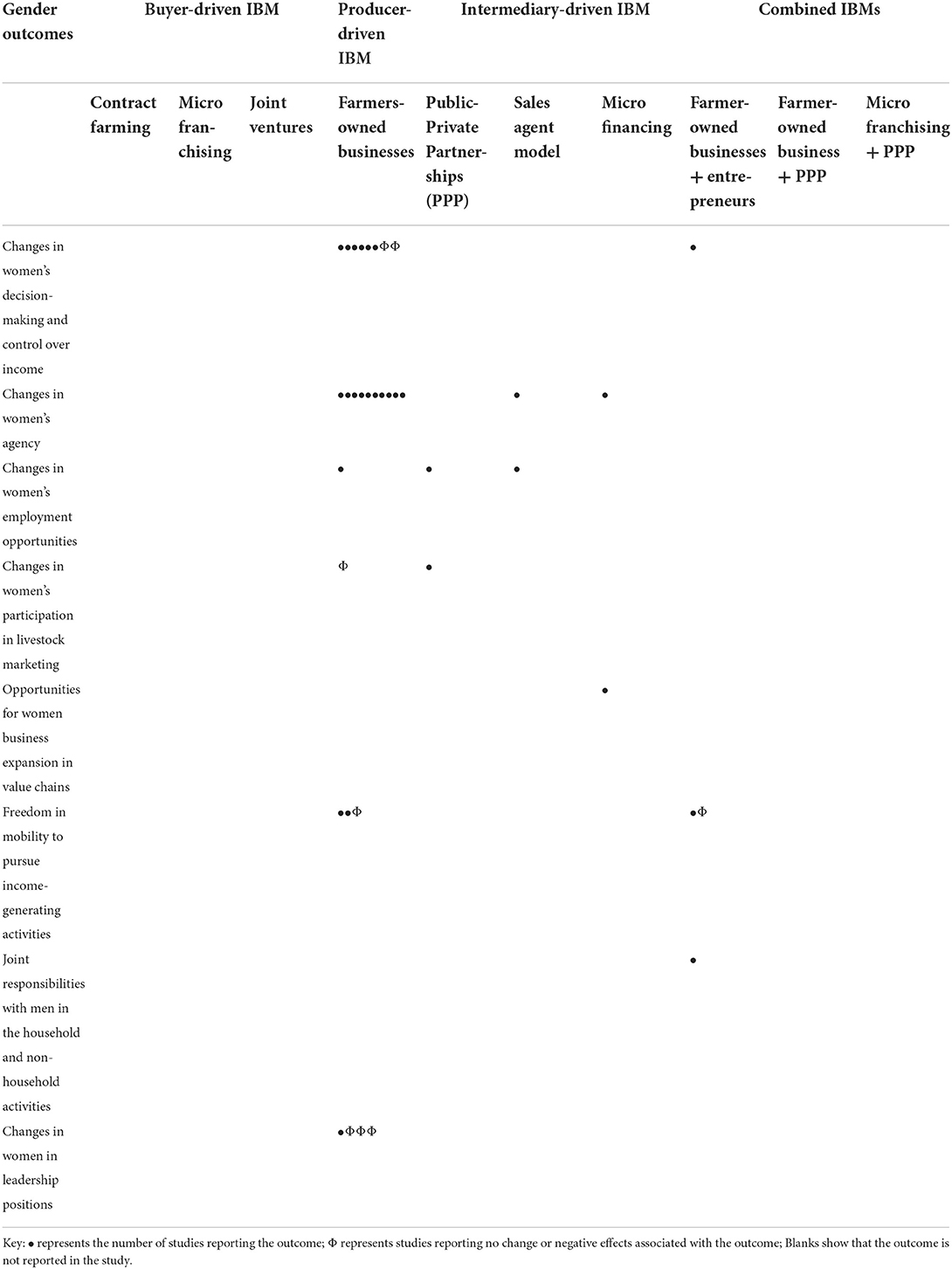
Table 6. Type of inclusive business model (IBM) and gender outcomes associated with empowerment and transformation of norms.
The farmer-owned businesses resulted in various benefit outcomes as well as women empowerment. The sales agent model resulted in employment opportunities, particularly for women who already enjoyed greater mobility in their culture due to age, marital and economic positions (MEDA, 2020). The studies reveal existing strong socio-cultural norms that hinder women from benefiting from IBMs. For instance, the Brooks and Ali (2015) study on Krishi Utsho micro franchising model shows that few women took advantage of the franchisee opportunity. This was largely due to the strong social norms preventing women from working in public, and in part due to lack of access to appropriate education or finance. Sarwar (2018) in their study on farmer-led businesses through self-help groups in Bangladesh show that while the meetings have improved collective decisions and actions and have contributed to women's ability to have access to income, the women in the groups are yet to take the major responsibility for trade since gendered norms and patriarchal attitude still prevails in the targeted communities.
Only 9 studies out of 29 reported some weaknesses of the studied IBM, either as limited or negative gender outcomes. A total of five studies cite restrictive gender norms (including mobility and leadership) to explain low women's participation in group meetings or training. In two studies, authors acknowledge that gender outcomes were not fully achieved as the interventions promoted activities falling in men's traditional domain (one on livestock trade and one on loans acquisition) that could not be lifted. Limited control over milk income by women was mentioned in two studies. One study reported a negative impact, related to the increased workload for women. The remaining 20 studies did not provide any information on possible shortcomings or negative effects on gender outcomes.
Discussion
The livestock sector offers opportunities for improved livelihoods for millions of small- and medium-scale farmers in low- and medium-income countries. Besides providing income and animal-source foods and constituting a store of wealth to their owners, livestock is also a pathway toward women's empowerment and progress toward gender equality. This paper looks at the specific case of business models and approaches for livestock and livestock products that can reach small-scale and agropastoral households, and potentially women, and those supporting progress on women empowerment or contributing to changes in gender norms. Out of nearly 1,500 screened papers, a total of 29 studies were included in our analysis as meeting the criteria of reporting a business model for livestock and having a gender outcome. In comparison, a similar review conducted for the aquaculture sector identified 36 papers, although the criteria were broader (Kaminski et al., 2020). Out of these 29 studies, 25 also reported a benefit for the women involved (e.g., a change in livestock income controlled by women), while 17 studies included a measure of women empowerment and 5 a change in gender norms. As for the agricultural sector with the WEAI tool, the livestock sector now has a tool to measure women empowerment (Galiè et al., 2019), and with more projects using the tool, more and better data will be available. While the number of studies identified is limited, important lessons can be drawn from this review.
First, while many recognize the potential for the livestock sector to contribute to progress toward women empowerment and gender equality, the evidence is scarce, and only about a third of the studies were published in peer-reviewed journals. Most of the evidence is documented in reports and project briefs, which raises questions about the quality of the analysis and the ability to learn lessons beyond projects.
Second, despite the limited number of studies, it is promising to see that more than half, 17 out of the 29 studies, do not stop at simple gender-outcome indicators (like reach and benefits) but also report women empowerment outcomes, mainly changes in women's decision making and control over income, and/or change in the agency. As Johnson et al. (2018) note, it is important for projects to include appropriate gender outcomes to be able to build the evidence base on factors driving women empowerment.
Third, the literature focuses on a particular type of IBM, the farmers “owned models of collective action (including cooperatives) that are used to support farmers” access to markets, inputs, and services, with 18 papers describing this approach. It is important to note that there are important variations within that type of IBM in terms of inclusiveness, see for example the case of dairy cooperatives in Mwambi et al. (2020) for Kenya and Ravichandran et al. (2021) for India. In other sectors, cooperatives are also a vehicle to progress toward gender equality, as detailed by Lecoutere (2017) for Uganda, in the case of the rice and cassava sector in Uganda (Theeuwen et al., 2021) and multipurpose cooperative in Nepal (Sharma and Shahi, 2022). Contract farming is the second most described IBM, with only 3 papers. Dairy and poultry interventions are the most common livestock species used in the included IBMs and more dairy interventions were associated with studies on the transformation of norms compared to the other livestock species. There is, therefore, a need to expand research to other types of IBMs and livestock species.
Fourth, the review has highlighted the need to conduct more rigorous studies, as some papers lack rigorous methods for measuring and tracking women's empowerment systematically (e.g., leadership positions or decisions over livestock or income). In addition, because many of the studies were published in reports or briefs, a major limitation of this paper is the underreporting of negative effects or no effects. Indeed only 9 studies out of 29 studies reported some weaknesses of the studied IBM.
Other limitations to our study need to be noted. First, the search terms and string, while including key terms, is narrow and did not include possible synonyms, including species name (e.g., poultry). Secondly, only papers in English were searched, which limited the identification of papers from various regions (Latin America, West Africa, and parts of Asia). Thirdly, the small number of papers included did not allow us to conduct a meta-analysis, resulting in a descriptive analysis, with no possibility to contrast IBMs by type, region, species, or outcomes.
Conclusions
Gender research in livestock has long focused on how gender differences and norms affect livestock development, for example how women and men differentiated access to information affects the uptake of livestock innovations. It is increasingly recognized that the relationship is also the other way round, how progress toward gender equality and women empowerment can be achieved through livestock development. This study focused on gender-inclusive business models literature and approaches that enhance the participation of women in the livestock sector, the benefits they derive, and progress toward women empowerment. Through a wide literature search, only 29 studies were identified and included in the analysis showing the scarcity of published literature in this field, and the few available lack rigor for measuring and tracking gender outcomes. The few studies report gender-outcome indicators and women empowerment outcomes associated with the IBMs, revealing the need for more rigorous studies to inform such interventions. The most common IBMs relate to farmers' collective action, with a focus on dairy and poultry businesses. About 40% (12 out of 29) of the studies limit their analysis to reach (i.e., number of women involved) and benefit (i.e., income change from participating), with the majority of papers, therefore, extending to women empowerment and/or gender norms outcomes. Increased control over income and decision-making is the dominant indicator; studies also refer to women's increased mobility, involvement in livestock marketing (a role usually reserved for men), taking up leadership positions in cooperatives, enhanced decision-making, and joint household responsibilities with men not only helping in livestock activities but also participate in household activities. As a government, development practitioners, and the society at large are looking for practical ways to progress toward gender equality, this paper shows that livestock offers such opportunities mainly through collective action but also contract farming and a variety of less common business models that may be worth testing and implementing in various livestock communities. Researchers and implementers should be encouraged to collaborate and implement “research in development” activities (Baltenweck et al., 2019), to strengthen research quality and rigor, in real-world situations. This would also include reporting possible negative effects of IBMs' interventions, on which valuable lessons can be learned.
Data availability statement
The original contributions presented in the study are included in the article/Supplementary material, further inquiries can be directed to the corresponding authors.
Author contributions
IB and EO conceived the study. IB, EO, and JN searched and reviewed the literature and extracted data. EO and JN analyzed the data. IB and EO drafted the manuscript and JN generated the references. All authors listed have made a substantial contribution to the work and have approved this submission for publication.
Funding
This work was supported by the CGIAR Research Program (CRP) on Livestock. The authors acknowledge all donors and organizations which support the CRPs through their contributions to the CGIAR Trust Fund. CGIAR is a global partnership that unites organizations engaged in research for a food-secure future.
Acknowledgments
The authors would like to thank David Aronson and Judy Kimani for proofreading and editing the manuscript.
Conflict of interest
The authors declare that the research was conducted in the absence of any commercial or financial relationships that could be construed as a potential conflict of interest.
Publisher's note
All claims expressed in this article are solely those of the authors and do not necessarily represent those of their affiliated organizations, or those of the publisher, the editors and the reviewers. Any product that may be evaluated in this article, or claim that may be made by its manufacturer, is not guaranteed or endorsed by the publisher.
Supplementary material
The Supplementary Material for this article can be found online at: https://www.frontiersin.org/articles/10.3389/frsus.2022.958251/full#supplementary-material
References
Asian Development Bank (2016). How Inclusive is Inclusive Business for Women? Examples from Asia and Latin America, Asian Development Bank. Available online at: http://www.adb.org/publications/inclusive-business-women-asia-and-latin-america (accessed May 14, 2020).
Baltenweck, I., Banerjee, R., and Omondi, I. (2019). Leveraging development programs – livestock research. In: Ferranti P, Berry EM, Anderson JR, editors. Encyclopedia of Food Security and Sustainability, Vol. 3 (Amsterdam: Elsevier), 401–410. doi: 10.1016/B978-0-08-100596-5.21564-3
Bamber, P., and Staritz, C. (2016). The gender dimensions of global value chains. Geneva: International Centre for Trade and Sustainable Development (ICTSD).
Becchetti, L., and Castriota, S. (2008). Is fair trade honey sweeter? An empirical analysis on the effect of affiliation on productivity. ECINEQ WP. 104, 2008–104. doi: 10.2139/ssrn.1428420
Beesabathuni, K., Lingala, S., and Kraemer, K. (2018). Increasing egg availability through smallholder business models in East Africa and India. Maternal Child Nutr. 14, e12667. doi: 10.1111/mcn.12667
Boros, R., and Mcleod, A. (2015). Empowering Women in Afganistan: Reducing Gender Gaps Through Integrated Dairy Schemes.
Brooks, C., and Ali, A. (2015). Krishi Utsho: The building of an Agro-Input Microfranchise Network in Rural Bangladesh.
Chamberlain, W., and Anseeuw, W (2017). Inclusive Businesses in Agriculture – What, How and for Whom? Critical insights based on South African cases, Inclusive Businesses in Agriculture.
Chege, G. K. C., Andersson, I. M. C., and Qaim, M. (2014). Impacts of Supermarkets on Farm Household Nutrition in Kenya, GlobalFood Discussion Papers. doi: 10.1016/j.worlddev.2015.03.016
FAO (2008). Business Models for Small Farmers and SME's. New Delhi. Available online at: file:///C:/Users/NM/Desktop/Literature Reiview Matrix References/FAO_Business_models_for_Small_Farmers_2008_1_.pdf.
FAO (2015). Inclusive Business Models. Guidelines for improving linkages between producer groups and buyers of agricultural produce, Organization, Food and Agriculture Nations, the United (FAO). Available online at: http://www.fao.org/3/a-i5068e.pdf. (accessed November 24, 2020).
FAO CARE (2019). Good Practices for Integrating Gender Equality and Women's Empowerment in Climate-Smart Agriculture Programmes. Food and Agriculture Organization. Available online at: https://www.care.org.au/wp-content/uploads/2016/09/Ethiopia-WR-endline-report-Final.pdf. (accessed April 28, 2020).
Farm Africa (2002). Microenterprise Development: Best Practices From FARM-Africa's Pastoralist Development Project in Kenya. Available online at: https://www.farmafrica.org/downloads/resources/Microenterprise-Development.pdf. (accessed September 07, 2020).
Galiè, A., Teufel, N., Korir, L., Baltenweck, I., Webb Girard, A., Dominguez-Salas, P., et al. (2019). The Women's Empowerment in Livestock Index. Soc. Indic. Res. 142, 799–825. doi: 10.1007/s11205-018-1934-z
German, L. A., Bonanno, A. M., Foster, L. C., and Cotula, L. (2020). “Inclusive business” in agriculture: Evidence from the evolution of agricultural value chains. World Development 134, 1–21. doi: 10.1016/j.worlddev.2020.105018
Johnson, N., Balagamwala, M., Pinkstaff, C., Theis, S., Meinzen-Dick, R., and Quisumbing, A. (2018). How do agricultural development projects empower women? Linking strategies with expected outcomes. J. Gender Agricul. Food Security 3, 1–19. Available online at: http://agrigender.net/views/agricultural-development-projects-empowering-women-JGAFS-322018-1.ph
Jordan-kirwan, S. (2019). Promoting Gender-Responsive Business Models in DRC: Lessons From ÉLAN RDC.
Kaminski, A. M., Kruijssen, F., Cole, S. M., Beveridge, M. C. M., Dawson, C., Mohan, C. V., et al. (2020). A review of inclusive business models and their application in aquaculture development. Rev. Aquaculture 12:1881–1902. doi: 10.1111/raq,.12415
KIT Agri-ProFocus, and IIRR. (2012). “Challenging chains to change: Gender equity in agricultural value chain development, Royal Tropical Institute (KIT). International Institute of Rural Reconstruction,” in Agri-ProFocus, eds A. Laven, R. Pyburn, and KIT. Amsterdam: Royal Tropical Institute (KIT). Available online at: http://www.agri-profocus.nl/wp-content/uploads/2012/09/131017-chachacha_Eng_web_2.pdf. (accessed April 30, 2020).
Lecoutere, E. (2017). The impact of agricultural co-operatives on women's empowerment: evidence from Uganda. J. Co-operative Organiz. Manage. 5, 14–27, doi: 10.1016/j.jcom.2017.03.001
Liverpool-Tasie, L. S. O., Wineman, A., Young, S., Tambo, J., Vargas, C., Reardon, T., et al. (2020). A scoping review of market links etween value chain actors and small-scale producers in developing regions. Nat. Sustain. 3, 799–808. doi: 10.1038/s41893-020-00621-2
Moher, D, Liberati, A, Tetzlaff, J, and Altman, DG.. (2009). The PRISMA group preferred reporting items for systematic reviews and meta-analyses: The PRISMA statement. PLoS Med. 6, e1000097. doi: 10.1371/journal.pmed.1000097
Mwambi, M., Bijman, J., and Mshenga, P. (2020). Which type of producer organization is (more) inclusive? Dynamics of farmers' membership and participation in the decision-making process. Annals Public Cooperative Econom. 91, 213–236. doi: 10.1111/apce.12269
Naguib, J., Oppermann, A., and Rosendahl, C. (2013). Inclusive Business Models Options for Support Through PSD Programmes. Deutsche Gesellschaft für Internationale Zusammenarbeit (GIZ), p. 40. Available online at: https://www.giz.de/fachexpertise/downloads/giz2014-ib-models-rz.pdf. (accessed April 28, 2020).
Oya, C., Schaefer, F., Skalidou, D., McCosker, C., and Langer, L. (2017). Effects of certification schemes for agricultural production on socio-economic outcomes in low- and middle-income countries : a systematic review. Campbell Systematic Rev. 3:246. doi: 10.4073/csr.2017.3
Peacock, C., and Hastings, T. (2011). Meru dairy goat and animal healthcare project. Int. J. Agricul. Sustain. 9, 203–211. doi: 10.3763/ijas.2010.0571
Pionetti, C., Adenew, B., and Alemu, Z. A. (2011). “Characteristics of women's collective action for enabling women's participation in agricultural markets: preliminary findings from Ethiopia,” in Gender and Market Oriented Agriculture (AgriGender 2011). p. 42.
Quisumbing, A. R., Roy, S., Tanvin, K., and Waithanji, E. (2014). Can Dairy Value-Chain Projects Change Gender Norms in Rural Bangladesh? Impacts on Assets, Gender Norms, Time Use. SSRN Electronic Journal. Discussion paper 01311. doi: 10.2139/ssrn.2407176
Ravichandran, T., Farnworth, C. R., and Galiè, A. A. (2021). Women-Only and Mixed-Gender Dairy Cooperatives in Bihar and Telangana, India: Is There a Difference for Women's Empowerment?. Agrigender, p. 1–26.
Rubin, D., Seyoum, T., and Caldwell, L. (2010). A Calf, a House, a Business of One's Own: Microcredit, Asset Accumulation, and Economic Empowerment in GLCRSP Projects in Ethiopia and Ghana. Global Livestock CRSp.
Salmon, G., Teufel, N., Baltenweck, I., Wijk, M. V., and Claessens, L. (2018). Trade-offs in livestock development at farm level: Different actors with different objectives. Global Food Security 17, 103–112. doi: 10.1016/j.gfs.2018.04.002
Sanginga, P. C., Njuki, J., and Waithanji, E. (2013). Women, Livestock Ownership And Markets: Bridging the gender gap in Eastern and Southern Africa, International Livestock Research Institute and the International. Edited by Jemimah; Njuki and P. C. Sanginga. New York, NY: International Livestock Research Institue and the International Development Research Centre.
Sarwar, R. (2018). Ensuring Sustainable Livelihoods of Small Holder Farmers through Beef and Dairy Value Chain Project (ESL) of Heifer International Bangladesh.
Seville, D., Buxton, A., and Vorley, B. (2011). Under What Conditions Are Value Chains Effective Tools for Pro-Poor Development? World. Available online at: http://pubs.iied.org/pdfs/16029IIED.pdf. (accessed April 28, 2020).
Sharma, L. K., and Shahi, M. B. (2022). Role of cooperatives in women empowerment: a case of Surkhet District, Nepal. Cognition 4, 43–54. doi: 10.3126/cognition.v4i1.46442
Stoian, D., Donovan, J., Elias, M., and Blare, T. (2018). Fit for purpose? A review of guides for gender-equitable value chain development. Dev. Practice 28, 494–509. doi: 10.1080/09614524.2018.1447550
Theeuwen, A., Duplat, V., Christopher, W., and Brian, T. (2021). “How do women overcome gender inequality by forming small-scale cooperatives? The case of the agricultural sector in Uganda”. Sustainability 13, 1797. doi: 10.3390/su13041797
Thorpe, J., Mathie, A., and Ghore, Y. (2017). A Typology of Market-Based Approaches to Include the Most Marginalised. Available online at: https://opendocs.ids.ac.uk/opendocs/bitstream/handle/123456789/12729/Atypologyofmarketbasedapproaches19_01.pdf%0A https://databankfiles.worldbank.org/data/download/GNIPC.pdf https://www.ids.ac.uk/publication/a-typology-of-market-based-approaches-to-include-the-most-marginalised.
Verhaegen, I., and Van Huylenbroeck, G. (2001). Costs and benefits for farmers participating in innovative marketing channels for quality food products. J. Rural Studies 17, 443–456. doi: 10.1016/S0743-0167(01)00017-1
Wane, A., Cadilhon, J. J., and Yauck, M. (2017). Socioeconomic impacts of innovative dairy supply chain practices – The case of the Laiterie du Berger in the Senegalese Sahel. Int. Food Agribusiness Manage. Rev. 20, 553–573. doi: 10.22434/IFAMR2015.0218
Were, T. (2009). Rewards From Twisted Roles: Case Study of Revitalised Livestock Marketing in Samburu, Northern Kenya. Available online at: http://www.bibalex.org/Search4Dev/files/338028/171501.pdf. (accessed August 28, 2020).
World Bank (2014). Levelling the Field: Improving Opportunities for Women Farmers in Africa. Available online at: https://www.worldbank.org/en/region/afr/publication/levelling-the-field-improving-opportunities-for-women-farmers-in-africa (accessed August 2, 2022).
World Bank (2021). Gross National Income per capita (2021). Atlas method and PPP. World Development Indicators Database. Available online at: https://coady.stfx.ca/wp-content/uploads/pdfs/Typology-market-based-approaches.pdfreplaces.
Keywords: inclusive business models, livestock value chains, women empowerment, low-and middle-income countries, reach, benefit, transform norms, gender
Citation: Baltenweck I, Ouma EA and Nagujja J (2022) Gender-inclusive business models in livestock value chains in low- and middle-income countries: What can we learn from the literature? Front. Sustain. 3:958251. doi: 10.3389/frsus.2022.958251
Received: 31 May 2022; Accepted: 09 August 2022;
Published: 12 September 2022.
Edited by:
Maria Barreiro-Gen, University of Gävle, SwedenReviewed by:
Juana M. Rivera-Lirio, University of Jaume I, SpainDalia D'Amato, University of Helsinki, Finland
Ugo Pica-Ciamarra, Food and Agriculture Organization of the United Nations, Italy
Copyright © 2022 Baltenweck, Ouma and Nagujja. This is an open-access article distributed under the terms of the Creative Commons Attribution License (CC BY). The use, distribution or reproduction in other forums is permitted, provided the original author(s) and the copyright owner(s) are credited and that the original publication in this journal is cited, in accordance with accepted academic practice. No use, distribution or reproduction is permitted which does not comply with these terms.
*Correspondence: Emily Awuor Ouma, RS5PdW1hQGNnaWFyLm9yZw==
 Isabelle Baltenweck
Isabelle Baltenweck Emily Awuor Ouma
Emily Awuor Ouma Janet Nagujja
Janet Nagujja